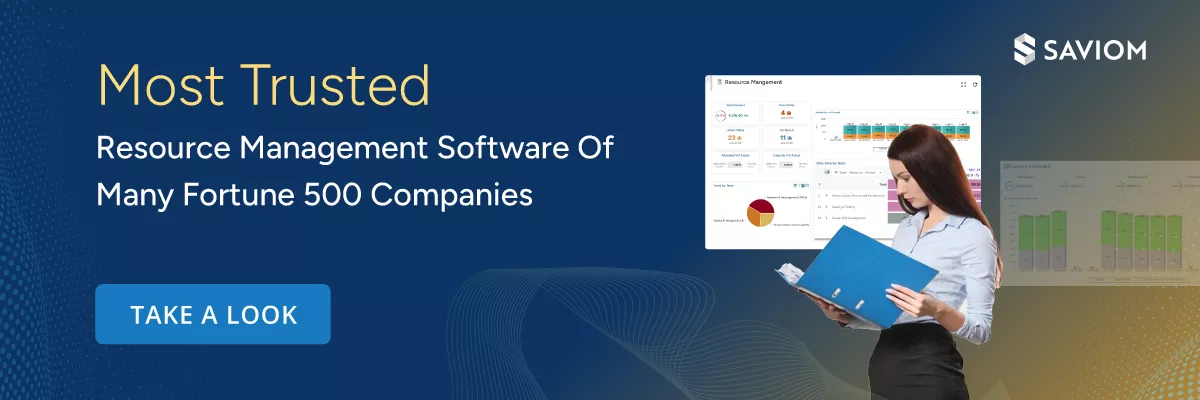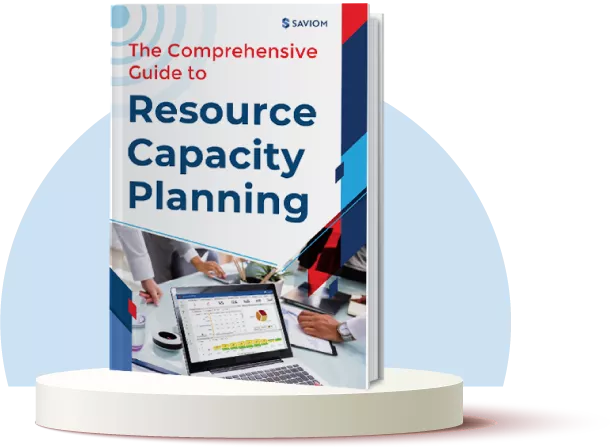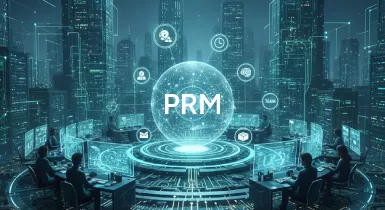Introduction
In today’s competitive business environment, organizations grapple with constant pressure to deliver projects faster, better, and at lower costs. At the same time, companies often struggle with limited budgets, tight deadlines, high resource costs, competing priorities, and insufficient personnel to complete the work. Consequently, many organizations find themselves reacting to problems rather than planning ahead. This is where resource management comes in.
It provides a structured framework for forecasting demand, planning capacity, and optimizing resource utilization to achieve better project and business outcomes.
When implemented thoughtfully, resource management empowers businesses to ensure the right people are working on the right projects at the right time. It also plays a key role in reducing resourcing costs, increasing project profitability, and enhancing operational efficiency.
In this comprehensive guide, we explore what resource management truly entails, why it’s a strategic imperative for modern enterprises, and how to implement it effectively.
But first, let’s understand the resource management definition.
What is Resource Management?
Resource management is the process of planning, forecasting, allocating, and optimizing organizational resources, including people, assets, equipment, finance, and tools to meet project and business goals. It ensures that the right resources are available at the right time and at the right cost.
Effective and efficient resource management yields significant advantages for enterprises. It streamlines resource allocation, which allows businesses to reduce project costs and enhance operational efficiency substantially. It also plays a pivotal role in optimizing how every resource is utilized across projects and business functions. Thus, it prevents both resource over-and underutilization, which in turn leads to a more balanced and sustainable workload for teams.
In conclusion, a well-structured resource management framework improves project delivery and significantly contributes to higher employee morale by reducing stress and fostering a more productive work environment.
Next, let us learn about the importance of resource management.
Why is Resource Management Important?
Resource management is the cornerstone of every organization aiming for long-term sustainability and profitability. It is a critical business function to streamline operations, optimize costs, and enhance project outcomes. Let’s deep dive to understand the benefits of resource management in the current business landscape.
Enhanced Visibility & Transparency
Resource management centralizes all resource-related information into a unified system, establishing a single source of truth. It allows managers to gain real-time insights into critical resource attributes, such as availability, allocation, cost rates, skills, roles, location, and utilization. This transparency helps firms identify potential resource constraints like over-or under-utilization, resource unavailability, skill gaps, etc. Consequently, managers can implement corrective measures ahead of time, streamline business workflows, and keep projects on track.
Optimized Resource Utilization
Effective resource management plays a pivotal role in maximizing the value of your workforce. It begins with accurately forecasting resource demand and proactively assigning the right talent to the right project, ensuring timely project initiation. Moreover, well-structured resource management practices help allocate skilled talent to high-value and billable projects that directly support strategic business objectives. Lastly, it helps prevent instances of underutilization, overallocation, and skill misalignment. This keeps the team engaged, motivated, and improves the overall resource health index.
Reduced Project Cost
Comprehensive resource management is essential for keeping project costs under control and preventing budget overruns. It helps in assigning the best-fit resources to the project at the right cost. This ensures optimal resource utilization and maximizes existing capacity, reducing unnecessary hiring. Moreover, with real-time visibility into resource attributes, such as cost and charge-out rates, managers can create accurate project budgets. Additionally, proactively identifying and addressing skill gaps early on helps organizations avoid last-minute firefighting, prevent unplanned expenditures, and improve overall cost efficiency.
Faster Project Delivery
Timely delivery of a project hinges on deploying the right resources to the right tasks. Effective resource management ensures that the necessary skills are available before the project execution begins. This prevents last-minute skill shortages and costly delays. Moreover, with clear visibility into resource availability, managers can create realistic schedules and respond swiftly to unexpected changes. Additionally, well-defined project resource management practices enable managers to quickly reallocate resources in response to shifting priorities and unplanned absenteeism. As a result, teams stay on track, and project momentum is maintained.
Enhanced Operational Efficiency
According to an IBM’s survey, “77% of CEOs view operational efficiency as a key driver of revenue growth, highlighting its strategic importance across industries.”
A well-defined resource management process supports this goal by providing a centralized view of resource data, thereby eliminating information silos and enhancing visibility across teams. Moreover, streamlining manual tasks such as resource requisitions and approvals minimizes administrative overhead, enabling teams to focus on high-impact activities. Additionally, tracking KPIs such as resource utilization and availability enables managers to proactively identify inefficiencies and take corrective actions. Together, these practices drive higher productivity and maximize operational efficiency.
Balanced Supply and Demand
Robust project resource management practices enable managers to forecast resource demand accurately for both ongoing and upcoming initiatives. By analyzing available capacity, they can quickly identify potential shortfalls or surpluses and take proactive steps, such as upskilling, reallocating resources, or hiring. This foresight helps avoid rushed staffing decisions and unnecessary over-hiring. Consequently, organizations can maintain the right balance of resource supply and project demand without overspending or falling short on critical skills.
Data-Driven Hiring Decisions
A well-structured resource management framework eliminates guesswork and approximation by providing real-time visibility into critical resource-centric attributes, such as skills, competencies, availability, capacity, and utilization. With these insights, managers can accurately identify and estimate the talent requirements ahead of time. As a result, organizations can hire the right people ahead of time, preventing last-minute firefighting and reactive staffing. Consequently, this approach minimizes the unnecessary hiring and firing cycle, helping to maintain an optimal talent pool.
Now that we have learned about the importance of resource management, let’s understand the key resource management methods in the following section.
Resource Management Techniques
Resource management techniques are methods employed to allocate and utilize various resources within an organization or project. The most critical techniques include:
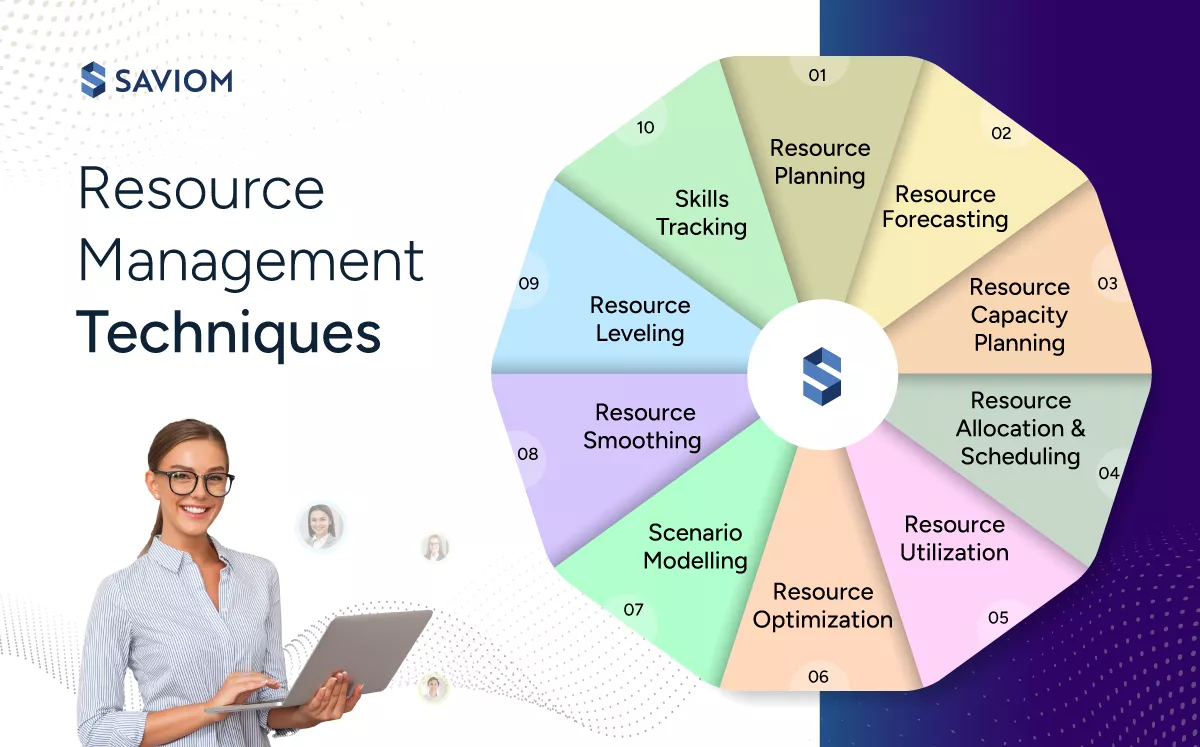
Resource Planning
Resource planning is the process of forecasting, identifying, allocating, utilizing, and managing resources, such as personnel, equipment, assets, finance, etc., to deliver projects successfully and achieve organizational goals. It involves estimating current and pipeline resource requirements based on critical criteria such as role, skill sets, location, etc., to ensure the best-fit resources are available at the right time and cost. The primary objective of effective resource planning is to optimize resource allocation, reduce unnecessary costs, and drive favorable project outcomes.
Dive deeper: What is Resource Planning? A Comprehensive Guide
Resource Forecasting
Resource forecasting is the process of predicting project resource metrics, such as demand, supply, utilization, and costs, over a specific period of time. It provides early warnings that help businesses be proactive and implement preventive measures to avoid resource-related roadblocks and ensure successful project delivery.
Resource Capacity Planning
Resource capacity planning is the process of forecasting, identifying, analyzing, and bridging the gap between resource demand and capacity. It involves proactively determining potential resource excesses or shortages within an organization and taking corrective actions ahead of time. This enables the timely delivery of projects within budget, balanced workload, optimum productivity, and enhanced operational efficiency.
Getting started with resource capacity planning? Read these blogs:
- What is Resource Capacity Planning? An Ultimate Guide
- What is a Capacity Report: Definition, Benefits & Steps to Build One
- Top Capacity Planning Challenges & 9 Ways to Overcome Them
Resource Allocation and Scheduling
Resource allocation and scheduling is the process of identifying and assigning the right resources, such as people, materials, facilities, equipment, etc., to the right project at the right time for a specific time period. This ensures the timely delivery of the projects within the budget, avoids underutilization or employee burnout, improves operational efficiency, and eliminates last-minute resource chaos.
Resource Utilization
Resource utilization refers to how effectively and efficiently organizations use resources against their total capacity to deliver projects successfully. It is a key metric for measuring billable, strategic, and high-value utilization of resources. It helps in reducing project costs, improving business profitability, and achieving higher strategic alignment.
Resource Optimization
Resource optimization is the process of strategically allocating and utilizing available resources such as people, assets, equipment, finance, and tools in the most effective and efficient way. It involves forecasting resource demand, performing scenario modeling, capacity planning, and implementing effective strategies to ensure every resource is utilized to its maximum potential. It ensures that the right resource is allocated to the right project at the right time, while maximizing cost efficiency, minimizing bench time, improving operational efficiency, and driving project success.
Dive deeper: What is Resource Optimization? Techniques, Types, & Best Practices
Resource Smoothing
Resource smoothing, or time-constrained scheduling (TCS), is an optimization technique that ensures efficient resource allocation without altering the project deadline. It involves redistributing tasks within the available float or deploying additional resources without affecting the project’s critical path. Effective resource smoothing helps ensure balanced workforce utilization, enhances overall resource health, and supports seamless project delivery.
Resource Leveling
Resource leveling or resource-constrained scheduling (RCS) is an optimization technique used for aligning the project schedule with resource availability. It involves adjusting project start and end dates to match the availability of critical resources such as personnel, equipment, materials, or facilities. The core objective of resource leveling is to overcome last-minute resource shortages, optimize resource allocation, maximize employee productivity, and ensure successful project delivery.
Explore further: Getting Resource Leveling Right for Projects
Scenario Modeling
Scenario modeling is a technique that allows organizations to simulate multiple scenarios in a controlled, sandbox environment. It involves adjusting key variables such as resources, project timelines, budgets, etc., to analyze and compare the outcomes of each scenario to arrive at the most effective resource plan. The primary objective of scenario modeling is to prevent resourcing bottlenecks, maintain project momentum, safeguard profit margins, and build resilience against market uncertainties.
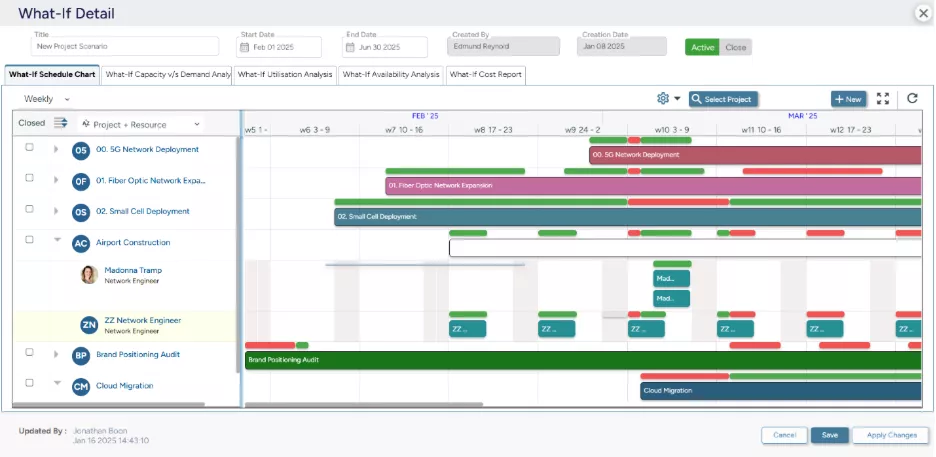 SAVIOM’s What-If Analysis empowers firms to compare and analyze multiple resource scenarios to come up with the most profitable outcome.
SAVIOM’s What-If Analysis empowers firms to compare and analyze multiple resource scenarios to come up with the most profitable outcome.
Skills Tracking
Skills tracking is the process of identifying, recording, monitoring, and maintaining employee skills, competencies, certifications, etc., in a centralized repository. It involves identifying and bridging skill gaps across teams by investing in targeted training and upskilling initiatives to build a future-ready workforce. The core objective of skills tracking is to develop employee capabilities, seize new opportunities, and maintain a competitive edge.
Now that we are familiar with resource management methods, let’s discuss the most pertinent resource management problems that modern-day businesses face.
What are the Common Challenges of Resource Management?
Despite best efforts and planning, organizations still encounter several roadblocks that hinder effective resource management in project management. Some of the most common resource management challenges are:
Lack of Enterprise-Wide Visibility
Many organizations still rely on simple spreadsheets and legacy tools to plan and manage their resources. However, these outdated solutions fail to provide real-time, consolidated data, creating information silos. Moreover, the absence of a centralized platform limits comprehensive visibility into future project requirements or company-wide resource availability. This impedes managers’ ability to forward plan and allocate the best-fit people to every project. Consequently, the lack of enterprise-wide visibility often results in reactive decision-making and impacts project outcomes.
Inadequate Resource Forecasting
According to an RMI survey, “75% of the respondents still use spreadsheets to support their resource forecasting needs.”
Even today, many organizations continue to rely on guesswork to assess their current and future resource requirements. Moreover, reliance on legacy tools and home-grown solutions further exacerbates the problem as it impedes visibility of resource capacity across the enterprise. This lack of foresight, combined with inadequate forecasting techniques, results in inaccurate resource estimations and poor project budget planning. Subsequently, inadequate resource forecasting leads to last-minute firefighting, cost escalations, and project delays.
Poor Capacity Planning
In today’s unpredictable business environment, organizations often face fluctuating client demands and shifting project priorities. Moreover, in the absence of comprehensive visibility and advanced forecasting capabilities, firms struggle to identify, analyze, and bridge capacity vs. demand gaps, leading to a resource surplus or deficit. An excess of resources adds to the bottom line; meanwhile, a resource shortage means critical projects cannot take off on time. Therefore, poor capacity planning can lead to frequent hiring/firing cycles and hamper an organization’s ability to meet dynamically changing business needs.
Scheduling Conflicts
Scheduling conflicts occur when a single resource is assigned to multiple tasks or projects during overlapping timeframes. This challenge often arises due to a lack of real-time visibility into current and future allocations, resulting in skill mismatches, double booking, overbooking, or the unavailability of critical resources. Scheduling conflicts can have a detrimental effect on workforce productivity. When not addressed promptly, last-minute rescheduling can further disrupt workflows and lead to operational inefficiencies, ultimately straining client relationships.
Read this infographic to know more about resource scheduling challenges: 8 Common Resource Scheduling Challenges & Ways to Solve Them
Sub-Optimal Resource Utilization
Sub-optimal resource utilization is a common challenge that can have significant consequences on the organization’s top and bottom line. Without an advanced resource management tool and a structured framework, firms often struggle to track and optimize resource utilization levels in real-time. They fail to recognize and mobilize resources from non-billable, low-priority work to revenue-generating tasks or address instances of under- or overutilization. As a result, this resource imbalance leads to a wide array of issues such as burnout, disengagement, unplanned attrition, billable losses, and missed business opportunities.
Skill Shortages
One of the most pressing resource management challenges that firms are facing is the growing skill shortages, especially in niche or specialized areas. This pertinent gap between available skills and required expertise often stems from factors such as rapid technological evolution, a lack of structured upskilling/reskilling, and the absence of an updated competency matrix. Consequently, organizations resort to expensive last-minute hiring or depend on external vendors to fill urgent skill gaps, resulting in cost escalations. This approach may offer short-term relief, but it compromises the firm’s ability to innovate and consistently deliver high-quality outcomes.
Having explored the most common resource management problems, let us now understand some proven resource management best practices that every manager must know to tackle them effectively.
What are the Best Practices for Effective Resource Management?
In today’s competitive market, making the most of every resource is essential to drive business growth. Below are key resource management strategies that organizations should implement to achieve this.
Forward Plan and Forecast Resource Demand for Upcoming Projects
Organizations should leverage historical data and advanced forecasting techniques to estimate resource demand for upcoming pipeline projects proactively. By analyzing project pipeline data early, businesses can determine the required resource types, quantity, and quality in advance. This forward planning enables managers to identify potential gaps early on, avoid last-minute resourcing chaos, and ensure seamless project initiation.
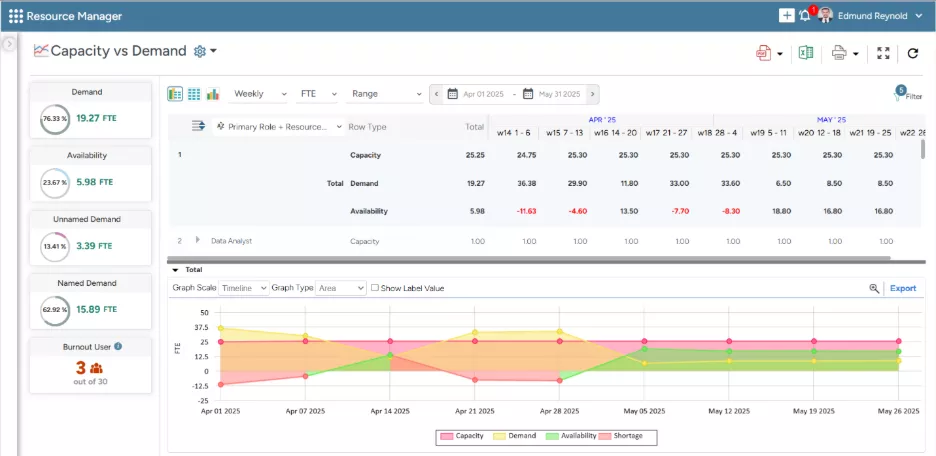 SAVIOM’s Capacity vs. Demand dashboard helps managers identify demand gaps, enabling quick, data-driven decisions.
SAVIOM’s Capacity vs. Demand dashboard helps managers identify demand gaps, enabling quick, data-driven decisions.
Streamline Resource Requisition Workflow Across the Business
Establish a clear, standardized resource requisition workflow to ensure consistent project requests. This gives a resource manager sufficient lead time to forecast, secure, and assign the best-fit resources to projects. Additionally, the process helps maintain an audit trail that ensures every allocation decision is well-documented and traceable. This, in turn, promotes transparency, helps eliminate favoritism, reduces internal conflicts, and supports smooth project execution.
Keep reading: What is a Resource Request Workflow? 6 Steps to Do it Right
Proactively Identify and Address Capacity Gap
Managers must evaluate the resource requirements of pipeline projects while simultaneously assessing internal capacity to determine if sufficient resources are available. Based on this analysis, firms can take timely remedial actions such as upskilling current employees, reallocating resources across projects, initiating external hiring, etc., to bridge any gaps. These measures help optimize resource allocation, reduce unnecessary costs, and ensure successful project delivery.
Forecast and Optimize Resource Utilization Early
Forecasting resource utilization across billable, non-billable, strategic, low-, and high-value work is essential to identifying inefficiencies early. This foresight enables firms to promptly reallocate resources to revenue-generating and business-critical projects to improve billability. In addition, tracking resource utilization levels helps ensure that the workforce is neither overloaded nor underutilized. And even if imbalances arise, early visibility gives firms the lead time to proactively adjust workloads, optimize resource utilization, and improve business profitability.
Track Workforce Competency in Real-Time Across the Organization
Organizations should maintain a real-time skill inventory of employees’ competencies, certifications, experience, roles, and other relevant information. By leveraging the skills matrix, managers can seamlessly schedule the right resources to the right tasks. Furthermore, firms can identify talent gaps early, allowing for proactive upskilling or targeted hiring. This data-driven approach ensures that critical work is handled by the most qualified resources, boosting operational efficiency and improving project outcomes.
Gain a deeper understanding: What is Skill Matrix, and Why is it Important for Business Success?
Monitor Resource Metrics for Data-Driven Decision-Making
Tracking resource-related metrics like capacity, availability, utilization, forecast vs. actual time, etc., in real-time is critical for managing resources effectively. Managers can utilize real-time BI dashboards and reports to track these metrics, identify trends, and pinpoint inefficiencies. Consequently, firms can take data-driven resource planning decisions to address variances, maximize productive utilization, improve operational efficiency, and drive business profitability.
Leverage Scenario Planning to Optimize Resource Allocation
Managers can perform scenario planning to simulate and test different resource allocation strategies across projects. By generating multiple “what-if” scenarios, managers can compare multiple outcomes even in a resource-constrained environment and choose the most cost-effective resource plan. This helps overcome resourcing bottlenecks, maintain project momentum, safeguard profit margins, and enable organizations to become more agile, resilient, and future-ready.
Now that we have explored resource management strategies, let’s examine what’s next in store for resource management.
Emerging Trends in Resource Management
In recent years, the resource management domain has experienced a significant shift fueled by dynamic market forces, technological advancements, and growing pressure to optimize costs. To maintain a competitive edge, businesses must stay informed of these emerging trends. Let’s understand them in detail.
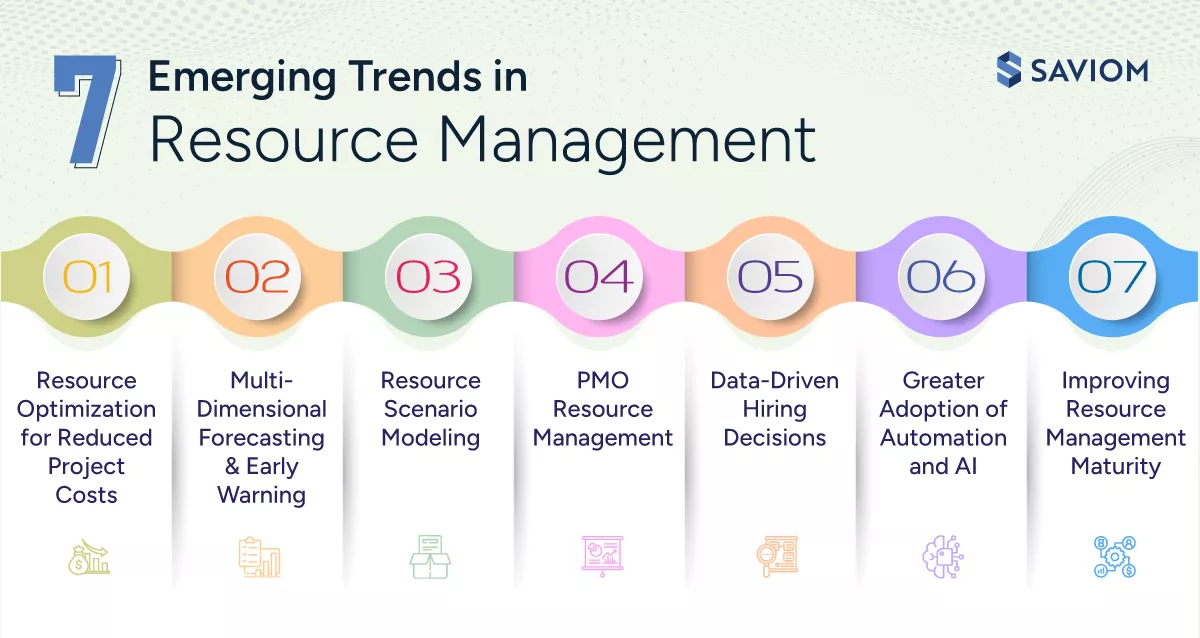
Leveraging Resource Optimization for Reducing Project Costs
Amidst hypercompetition and rising costs, firms are increasingly turning to resource optimization to control project expenses. These strategies enable firms to ensure competent resource allocation and prevent over- and underutilization.
This helps minimize employee burnout, reduce bench time, and avoid financial inefficiencies. Effective resource optimization strategies also help prioritize high-value tasks and roles, ensuring limited resources deliver maximum impact and strengthen the firm’s financial performance.
Multi-Dimensional Forecasting & Early Warning
Organizations are gradually adopting multidimensional forecasting models to proactively assess future resource needs across various dimensions, such as roles, skills, departments, teams, line managers, etc. It enables project stakeholders to visualize data according to their specific requirements and take targeted measures accordingly.
Additionally, with an early warning system in place, managers are well-equipped to take timely action to address any potential risks, such as overbooking, double-booking, employee burnout, bench wastage, sub-optimal utilization, etc.
Resource Scenario Modeling for Faster Project Delivery
Resource scenario modeling is emerging as a key practice for optimizing resource-centric processes and improving risk preparedness in complex project environments. It enables organizations to simulate and test multiple allocation strategies while assessing the impact of varying resource constraints in terms of personnel, budget, time, etc.
By comparing various scenarios, decision-makers can pinpoint the most profitable resource plan, prevent resource-centric bottlenecks, enhance future-readiness, and ensure faster project delivery.
PMO Resource Management Becoming More Strategic
PMOs are evolving from traditional administrative roles into strategic functions that directly influence business outcomes. They play a pivotal role in streamlining critical resource-centric workflows such as planning, allocation, and utilization to optimize workforce capacity and minimize resourcing conflicts.
Beyond standardizing processes, PMOs drive value by managing complex project portfolios and aligning resources with strategic business goals. This leads to a more productive workforce, successful project outcomes, and a higher ROI.
Data-Driven Upskilling and Hiring Decisions
Traditionally, upskilling and hiring decisions were largely based on guesstimation, leading to skill misalignment. Modern businesses are replacing this with data-driven workforce planning that provides real-time visibility into resource attributes like skills, competencies, and utilization, which help accurately identify instances of any gaps.
This enables firms to initiate targeted upskilling and reskilling programs to build a resilient workforce. By aligning the internal talent pool with long-term objectives, firms can improve employee productivity, enhance project delivery, and stay competitive.
Increased Automation and Usage of AI
Global enterprises are increasingly integrating AI and automation into their resource planning processes to enhance accuracy, speed, and scalability. AI-powered algorithms and skill-matching engines leverage real-time data to match the right talent for the right project at the right time, significantly boosting resource allocation efficiency.
At the same time, firms are automating repetitive, mundane tasks such as resource requisitions, timesheet submissions, and leave approvals, freeing up critical resources to focus on high-value strategic activities.
Constantly Improving Resource Management Maturity
In today’s fast-changing, resource-constrained business environment, achieving higher resource management maturity is no longer optional; it is a critical competitive differentiator. Organizations are constantly striving to enhance their maturity level by moving beyond reactive allocation practices towards data-driven optimization.
To support this shift, firms are conducting regular assessments to benchmark current capabilities and identify areas of improvement. By achieving a higher level of maturity, firms can improve operational efficiency and achieve optimal business performance.
Having explored the various emerging trends in the resource management domain, let’s look at the key KPIs that matter most.
Resource Management KPIs
Here are the essential resource management KPIs every manager should track to ensure projects are delivered on time and within budget. Let’s take a closer look.
Resource Utilization Rate
The resource utilization rate is a critical metric that measures how effectively resources, such as employees, equipment, and tools, are utilized against their total available capacity. It helps firms identify instances of under- and overutilization and take corrective action to prevent burnout and disengagement. Therefore, this KPI enables organizations to optimize resource allocation, improve productivity, and boost project profitability.
Resource Demand Forecast Accuracy
Resource demand forecast accuracy refers to the degree to which an organization’s predicted resource demand aligns with the actual resources required. It helps firms understand the reliability of their resource planning and whether adjustments are necessary. Thus, the resource demand forecast accuracy metric empowers businesses to make data-driven decisions about hiring, allocation, and utilization.
Resource Availability Rate
Resource availability rate is the percentage of time a resource (human or non-human) is available to perform productive work within a specific timeframe. It quantifies the portion of a resource’s total capacity that can be assigned to tasks, taking into account current commitments, scheduled leave, maintenance, and other organizational constraints.
Resource Allocation Effectiveness
Resource allocation effectiveness measures how appropriately an organization assigns its available resources, such as people, equipment, and finances, to tasks and projects to achieve optimal results with minimal waste. It reflects the organization’s ability to align resources with top priorities, ensuring that the right resources are allocated to the most suitable activities at the right time and at the optimal cost.
Forecast vs. Actual Time
Forecast vs. actual time compares the estimated hours a resource is expected to spend on assigned work with the actual hours recorded. This metric enables managers to evaluate the accuracy of planned work hours in relation to actual hours worked, identify discrepancies, and take corrective actions to bridge the gap.
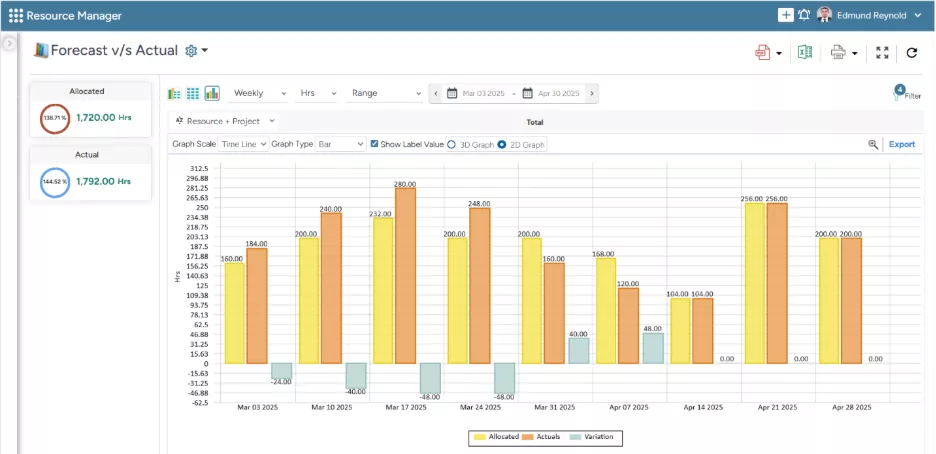 SAVIOM’s Forecast vs. Actual Time report helps managers assess the variance between the booked hours and the actual time taken by resources to complete their work.
SAVIOM’s Forecast vs. Actual Time report helps managers assess the variance between the booked hours and the actual time taken by resources to complete their work.
Revenue Per Resource
Revenue per resource is a metric that measures the amount of revenue generated by each resource within a specific timeframe. It provides valuable insight into how effectively the organization leverages its workforce to achieve business goals and drive profitability.
Resource Turnover Rate
The resource turnover rate is a key metric that measures the frequency at which employees or other resources leave an organization and are replaced within a specified period. It is typically shown as a percentage and provides critical insight into workforce stability and retention.
Now, let us walk through the essential steps for creating a well-structured resource management plan.
How to Build an Effective Resource Management Plan?
The following steps will help you develop a detailed resource management plan that ensures optimal utilization and successful project delivery.
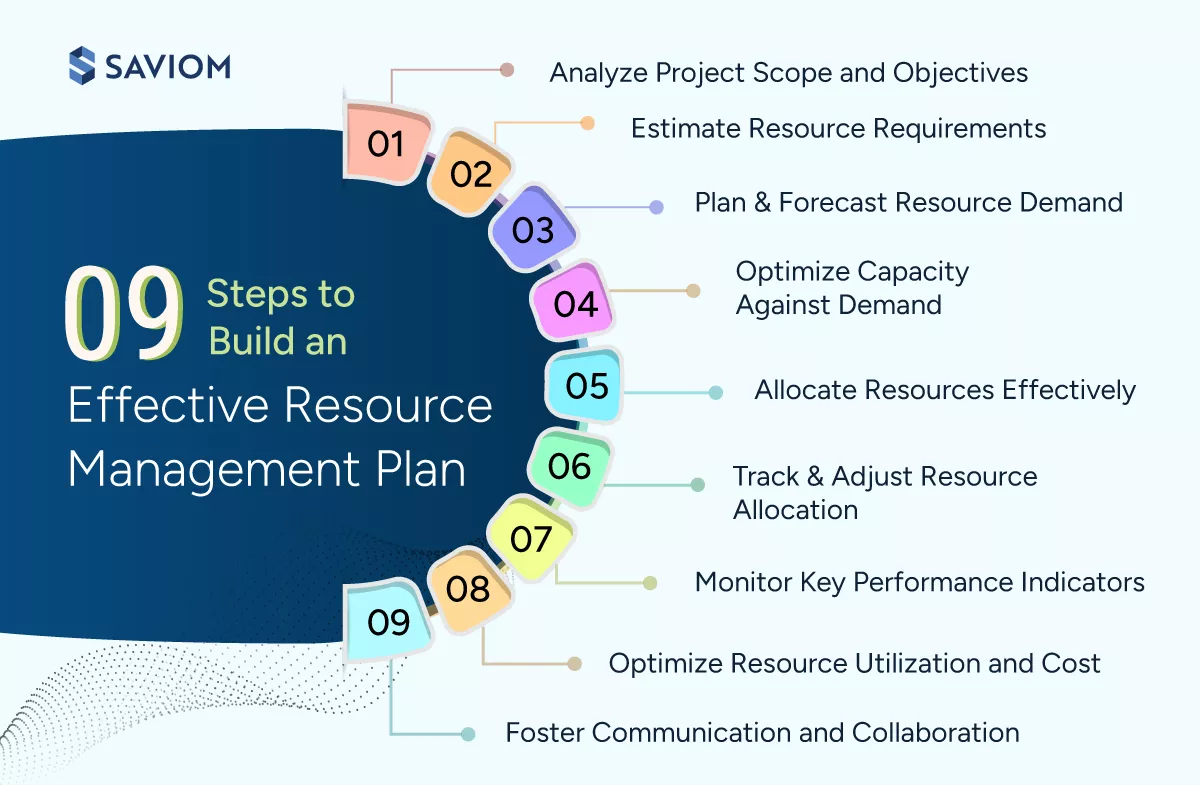
Analyze Project Scope and Objectives
Creating an effective resource management plan begins with clearly defining the project’s scope and objectives. It involves outlining key deliverables, timelines, and milestones. Moreover, project managers can involve stakeholders early in the process to align key priorities, resource constraints, and potential risks. This ensures the timely identification of roadblocks and supports informed decision-making. Lastly, managers can define the project deliverables and set performance metrics to track progress and ensure successful delivery.
Estimate Resource Requirements
The second step involves estimating the type, quantity, and quality of resources needed to complete the project. This ensures that skilled resources are allocated to tasks, minimizing errors and maintaining quality. Once the competencies are outlined, project managers can estimate the efforts (in hours, days, or FTE) required for each deliverable. Based on the effort, the project’s complexity, and timelines, managers can determine the approximate number of resources required. Complex projects may require more specialized roles, while tighter timelines may demand additional support. This macro-level estimation ensures that the project is adequately staffed to meet delivery deadlines without over- or under-allocation of resources.
Plan and Forecast Resource Demand
Next, managers can map the estimated effort across the project timeline to determine exactly when each role will be required. This process involves breaking the project into different phases and aligning resource requirements with the specific tasks and milestones of each phase. By doing so, managers can specify the precise number of resources per role, their required duration, and the planned start and end dates for each position. These detailed insights clarify who is needed and when, while also facilitating proactive coordination with the recruitment team and external vendors. Ultimately, this foresight enables timely onboarding and offboarding, making resources available precisely when required.
Optimize Capacity Against Demand
In the fourth step, managers can evaluate whether existing resource capacity aligns with forecasted demand for each role across the project timeline. This assessment helps identify potential resource excesses or shortages well in advance. In case of a shortfall, managers can decide whether to cross-train, reassign resources, or engage in external hiring to address critical gaps. As an alternative, firms can prioritize high-value or urgent projects by reallocating resources from lower-priority work. Additionally, managers can leverage what-if analysis to model multiple scenarios under resource constraints and develop a suitable capacity plan to ensure uninterrupted project execution.
Continue reading: How to Measure Resource Capacity and Demand?
Allocate Resources Effectively
After optimizing capacity, managers can assign the best-fit resources to each task by considering factors such as skills, availability, location, interests, and cost. When assigning work, they can also consider resource preferences and career development goals. This helps boost employee engagement and supports long-term retention. It is also essential to prioritize staffing for critical roles to avoid delays in key deliverables. At the same time, they should also balance workloads across teams to prevent over- or under-allocation of resources. Ultimately, allocating resources strategically helps organizations enhance team productivity and deliver projects successfully.
Track and Adjust Resource Allocation
As projects progress, resource requirements can shift due to scope changes, increased task complexity, or client feedback. A robust resource management plan ensures resource allocations are reviewed and updated regularly to meet these evolving demands. Additionally, it’s essential to reassign or release resources immediately after task completion to reduce bench time and maximize utilization. Conversely, when workload increases or project requirements change, managers can raise timely requests for additional resources to help prevent delays and bottlenecks. These ongoing adjustments control project costs and ensure resources are consistently aligned with shifting priorities.
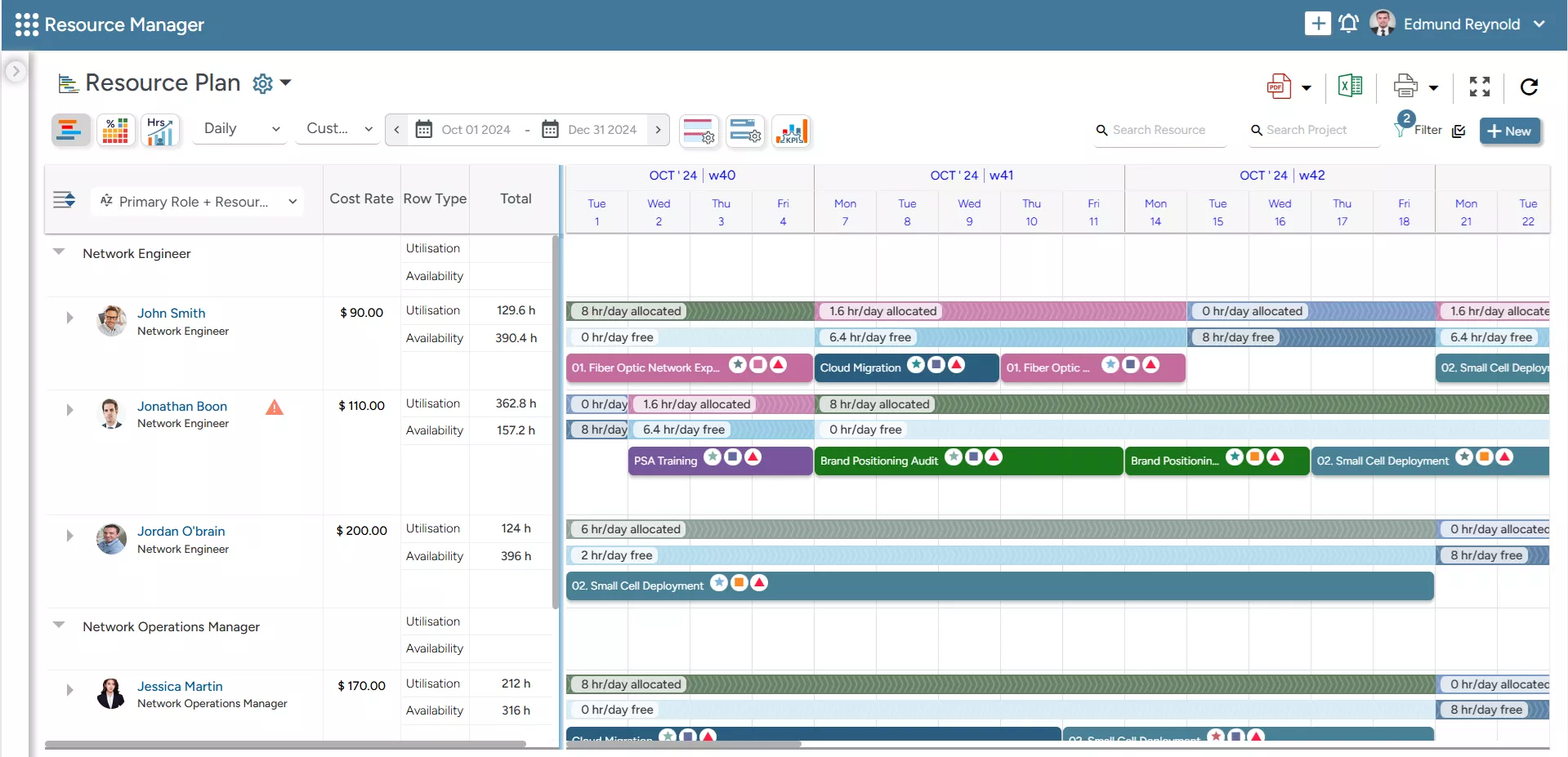 SAVIOM’s Resource Planner helps managers to proactively track and optimize resource allocations.
SAVIOM’s Resource Planner helps managers to proactively track and optimize resource allocations.
Monitor Key Performance Indicators
A well-structured resource management also includes tracking key resource-related KPIs, such as utilization rate, availability rate, and forecast accuracy. These metrics help evaluate how effectively resources are being used throughout the project lifecycle. By comparing actual data against predefined baselines, managers can quickly identify deviations such as resource under-allocation, overutilization, or budget overruns. Consequently, they can implement timely course corrections to resolve issues early and prevent negative impact on project outcomes. Additionally, these data-driven improvements contribute to better resource control and overall project success.
Explore further: 9 Resource Management KPIs That Every Business Must Track
Optimize Resource Utilization and Cost
After monitoring KPIs, managers can forecast utilization across billable, non-billable, strategic, low-value, and high-value tasks to identify inefficiencies early. With these insights, they can reallocate resources from low-priority or non-billable work to strategic, revenue-generating tasks, reducing bench time and preventing overutilization. Additionally, deploying skilled resources to high-value projects maximizes utilization, controls cost, and improves ROI. Collectively, these targeted actions enhance resource efficiency, ensure the successful delivery of projects, and strengthen overall financial performance.
Foster Communication and Collaboration
Finally, it is vital to leverage a centralized communication platform to share real-time updates on project resource attributes, such as resource availability, deliverables, and timelines. Moreover, firms can promote regular check-ins between project managers, team leads, and resource managers to align efforts with shifting priorities and evolving resource needs. In addition, organizations can foster cross-functional collaboration to reallocate resources seamlessly across teams and departments. This flexibility minimizes delivery bottlenecks, enhances adaptability, and ensures that resources are deployed where they deliver the greatest value.
The following section discusses what resource management maturity is, and how your organization can advance to the next level.
How to Accelerate Your Resource Management Maturity?
By reaching the highest level of maturity, businesses can unlock significant benefits, including reduced resourcing costs, streamlined allocation processes, optimal resource utilization, and more. But how can organizations get there? Here’s what you need to know.
What is a Resource Management Maturity Model?
Resource Management Maturity Model is an enterprise-wide framework that enables organizations to assess and enhance their resource management processes and capabilities. It encapsulates strategies, tools, methodologies, and informed decision-making that help firms utilize business resources effectively and efficiently. The model provides a structured approach to systematically evaluate an organization’s current resource management practices, identify areas of improvement, and create a roadmap to achieve the desired maturity level.
Understanding Different Maturity Levels
Understanding different maturity levels in resource management allows organizations to benchmark their current capabilities and identify areas for improvement. Here are the different resource management maturity levels:
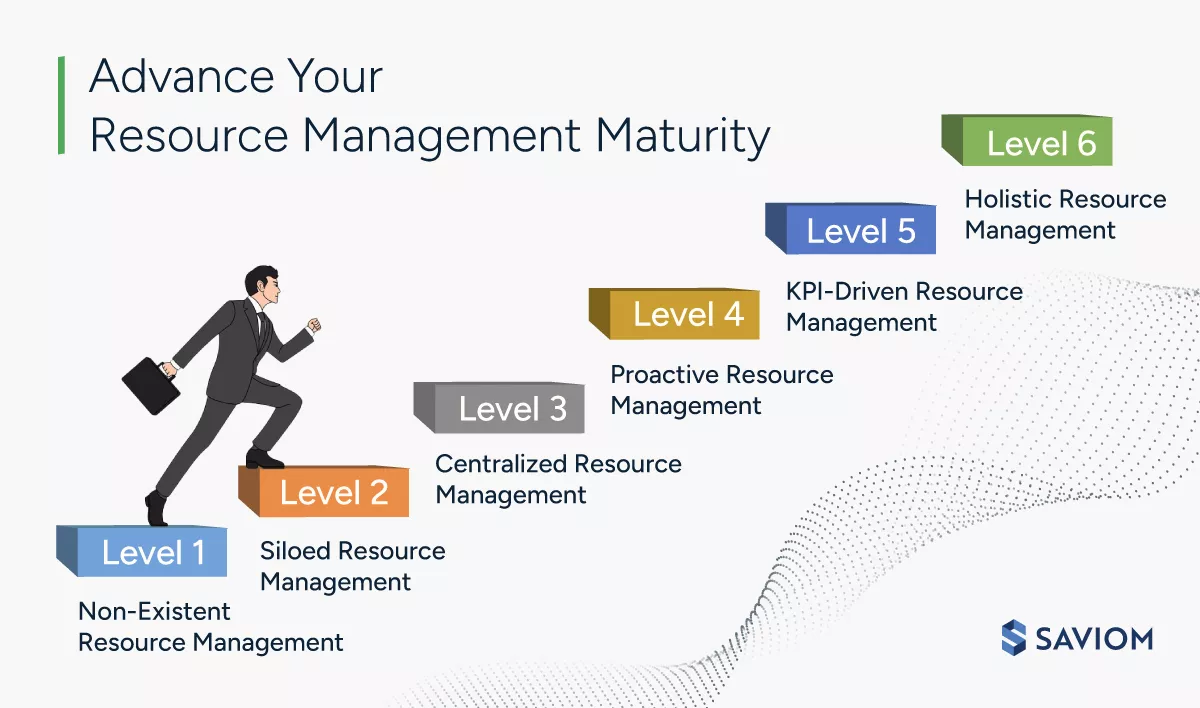
Maturity Level 1: Non-Existent Resource Management
At maturity level one, resource management is not recognized as a formal practice within the organization. There are no defined processes in place. Instead, delivery leaders or line managers are directly responsible for acquiring and assigning resources. This often results in last-minute, reactive decision-making regarding resource allocation.
Maturity Level 2: Siloed Resource Management
At maturity level two, resource management processes and governance are fragmented and typically managed independently at the team or department level. Some departments may have designated resource managers, but their roles are limited in scope. Most planning and tracking are done using spreadsheets or internally developed tools, with minimal integration across teams.
Maturity Level 3: Centralized Resource Management
At maturity level three, resources are viewed as part of a shared pool that can be allocated across different projects within the organization. Processes and governance models are standardized and centrally coordinated to support all departments. Resource managers operate in a federated model within individual departments or business units, ensuring alignment with overall enterprise goals.
Maturity Level 4: Proactive Resource Management
At maturity level four, the organization has established mature resource management processes that enable forecasting and forward planning for ongoing and upcoming projects. This approach ensures that the right resources are available at the right time, helping reduce costs and supporting timely and budget-compliant project delivery.
Maturity Level 5: KPI-Driven Resource Management
At maturity level five, a resource manager is accountable for meeting key performance indicators (KPIs) related to resource utilization, forecasting accuracy, allocation efficiency, bench strength, fill rates, and more. These metrics support data-driven decision-making and allow for continuous optimization of resource allocation across teams and departments, contributing to higher project success rates.
Maturity Level 6: Holistic Resource Management
At maturity level six, resource management is fully integrated into the organization’s strategic planning. It addresses both short- and long-term resource needs for project and non-project work. This holistic model covers the entire resource lifecycle, from onboarding to off-boarding, and plays a key role in driving sustainable growth and maintaining a competitive edge in a dynamic business environment.
Assessing Current Maturity Model
Firms can assess their current maturity model to evaluate how well their resource management practices align with their long-term goals. Below are the key steps to carry out this assessment.
- Conduct a structured evaluation of existing resource management practices to establish a clear baseline for maturity assessment.
- Identify core strengths, recurring inefficiencies, and operational bottlenecks within resource planning, forecasting, and allocation workflows.
- Examine the effectiveness of current tools, data integration, and reporting mechanisms in delivering real-time visibility and supporting timely decision-making.
- Engage cross-functional stakeholders-including PMO, HR, Finance, and Delivery-to collect qualitative insights and validate perceptions of current maturity levels.
- Analyze governance frameworks, process standardization, and ownership structures to uncover inconsistencies, redundancies, or risk-prone areas.
Determining the Targeted Maturity Model and Roadmap
Defining a targeted maturity model and roadmap helps organizations pinpoint the desired state of their resource management capability and outline how to reach it. The following steps provide a structured approach to this process.
- Define a clear and measurable target state for resource management maturity that aligns with the organization’s broader business strategy and transformation goals
- Map the desired end-state across key dimensions such as tools, processes, governance, skills, and data architecture
- Highlight the gaps between current and targeted maturity levels, and translate them into actionable focus areas
- Create a phased roadmap with prioritized initiatives, aligned to business needs and organizational readiness (e.g., centralizing data, enabling scenario-based forecasting, building skills inventory)
- Guide stakeholders in selecting or enhancing tools and platforms that can scale with maturity and support multidimensional forecasting, analytics, and collaboration
- Secure leadership buy-in and define clear roles and sponsorship to drive roadmap execution
Implementing the Maturity Model
Putting the maturity model into practice enables organizations to translate their resource management vision into actionable steps. The following section focuses on building core capabilities, embedding governance, and driving continuous improvement. Let’s understand.
- Implement foundational capabilities first, such as centralized resource inventory, standardized planning workflows, integrated tooling, etc., to build early momentum
- Embed cross-functional governance and steering mechanisms to ensure alignment, accountability, and escalation channels.
- Deliver robust change management programs including stakeholder communication, leadership alignment, and capability-building across resource managers, PMs, and operational leaders.
- Create feedback loops via KPIs and health metrics (e.g., utilization %, forecast accuracy, resource lead time, skills availability) to measure progress and course correct.
- Continuously evolve practices through quarterly retrospectives, maturity reassessments, and cross-team learnings to move toward a culture of strategic resource management.
Finally, let’s explore how SAVIOM empowers you to take your resource management to the next level.
SAVIOM Resource Management: A Game Changer
Here is why SAVIOM stands out as the ultimate choice of organizations aiming to improve their resource management processes and enhance financial performance.
Most Advanced and Powerful Solution
The current market landscape, marked by economic fluctuations and intense competition, places significant pressure on businesses worldwide to deliver more projects with fewer resources. To remain profitable and sustainable, firms must utilize their key assets, i.e., resources, efficiently. SAVIOM’s advanced and powerful resource management solution supports organizations in this critical endeavor. It enables firms to seamlessly manage resources, streamline complex business operations, maximize workforce productivity, and drive business growth.
Highly Configurable and Adaptable Solution
Every organization has its unique ways of working, in terms of workflows, reporting structures, approval hierarchies, etc. As such, a one-size-fits-all approach is no longer viable. Modern organizations require a configurable resource management solution like SAVIOM, which can be tailored to meet their unique business requirements without disrupting overall productivity. Further, it is designed to handle increasing workloads and data volumes as businesses grow, ensuring optimal business performance and improved profit margins.
5th Gen Resource Management Maturity
SAVIOM’s 5th gen resource management solution is designed to address the evolving resourcing challenges of modern businesses. Built from the ground up, it empowers organizations to manage their valuable resources most efficiently for successful project delivery. SAVIOM offers various advanced capabilities such as multi-dimensional forecasting, dynamic capacity planning, data-driven allocation, real-time optimization, scenario modeling, and more. These enable businesses to maximize profitable resource utilization, accelerate their resource management maturity, and maintain a competitive edge.
Pioneer and Market Leader of Resource Management
As a recognized market leader in the enterprise resource management field, SAVIOM has earned the trust of some of the world’s most respected organizations, including Fortune 500 companies and market leaders such as Verizon, Fujitsu, ABB, Siemens, Alix Partners, and Grant Thornton. Our solutions are deployed across diverse industries in 50+ countries, enabling global enterprises to optimize resource utilization, streamline project delivery, and achieve strategic business outcomes. With two decades of industry experience, SAVIOM software continues to influence and shape the future of resource management.
Achieve a High Return on Investment
With SAVIOM’s advanced forecasting and capacity planning capabilities, organizations can proactively address resource gaps and avoid costly last-minute staffing decisions. It also enables allocating the right expertise to projects by analyzing key attributes such as cost, availability, and skills, thereby enhancing productivity and keeping resource deployment within budget. Additionally, automated resource requisition and approval workflows reduce administrative overhead, allowing managers to focus on high-value, strategic work. As a result, SAVIOM’s next-gen resource management solution drives higher ROI and ensures that resources are utilized to their full potential.
